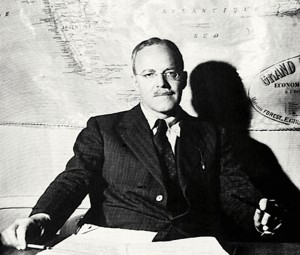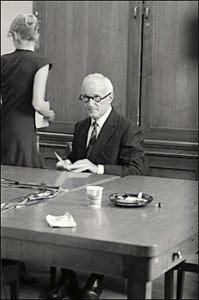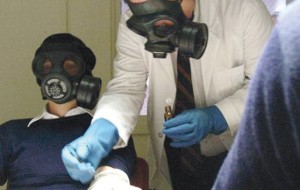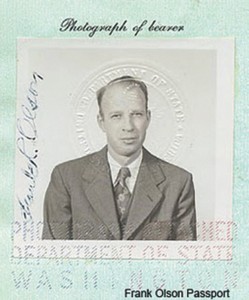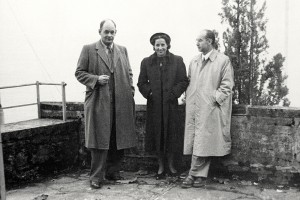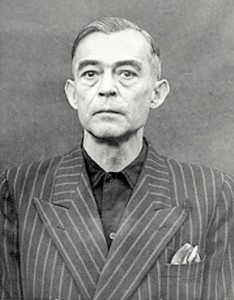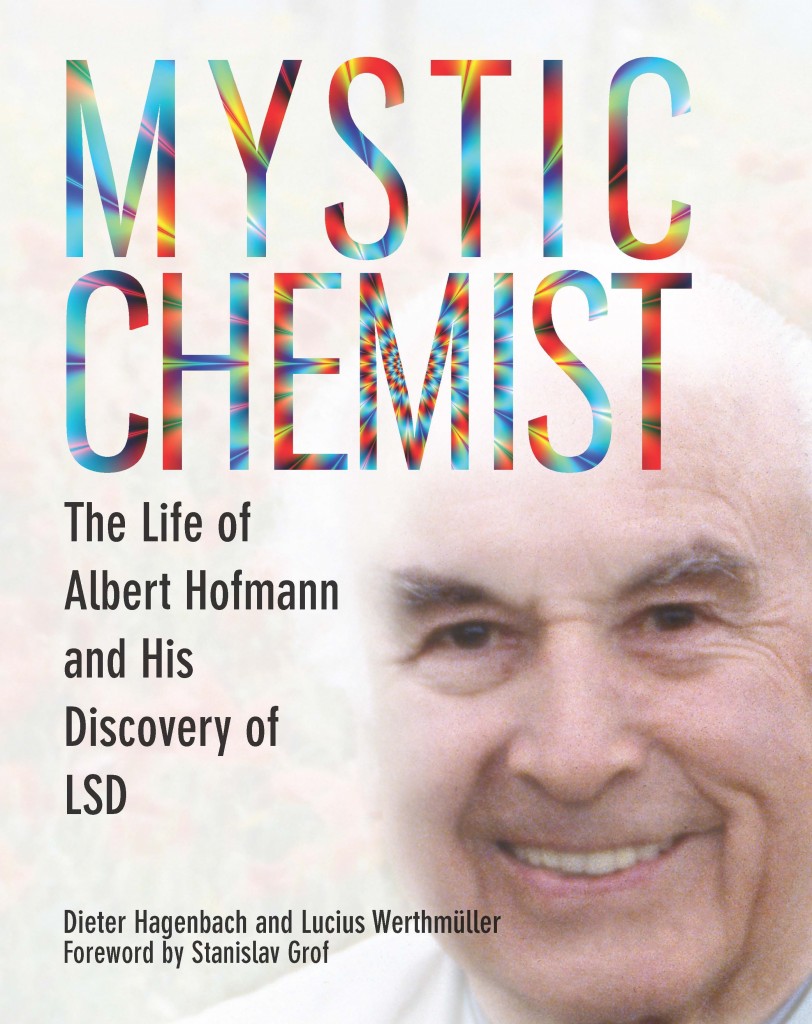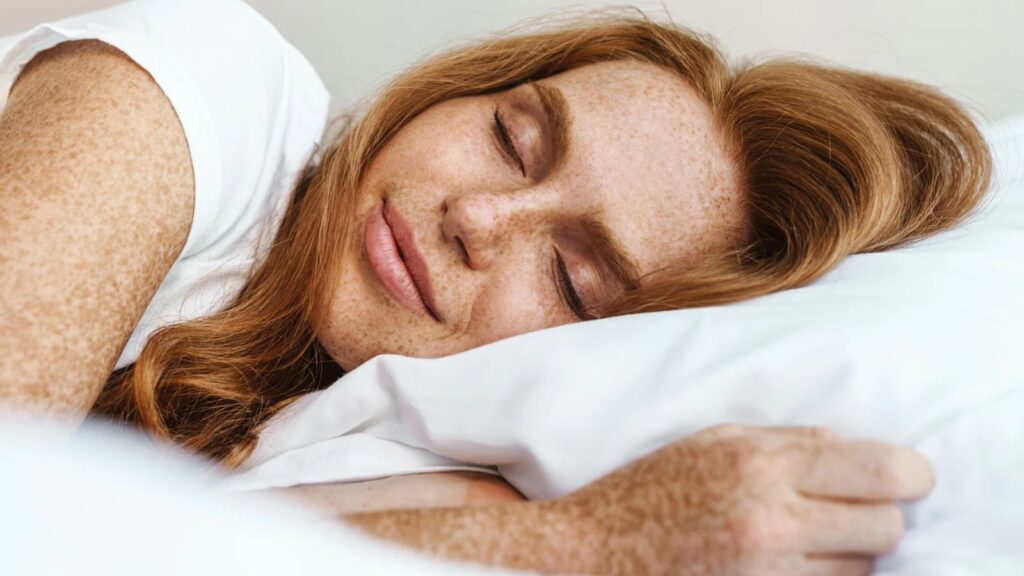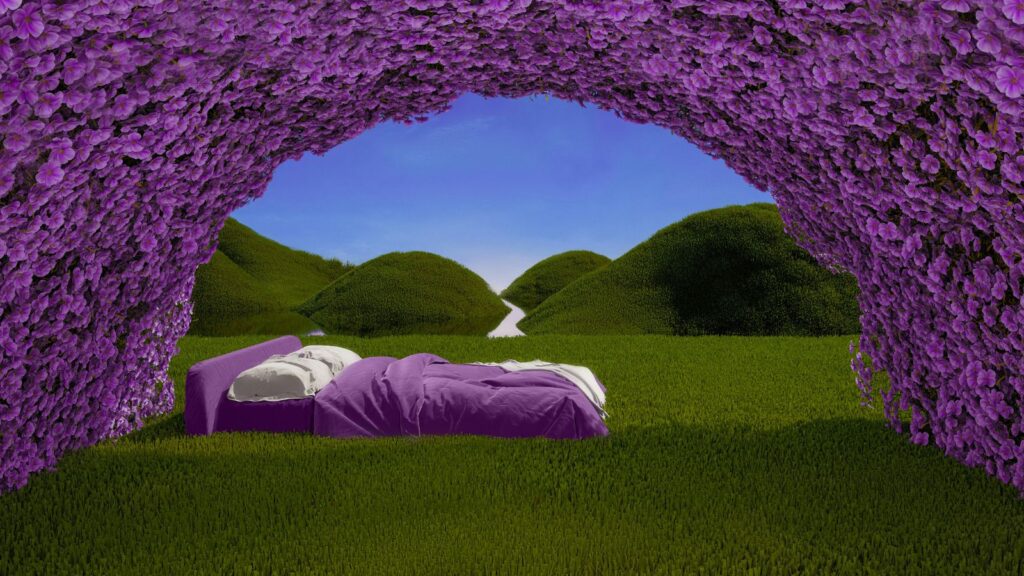The following on LSD is excerpted from Mystic Chemist: The Life of Albert Hoffman and His Discovery of LSD by Dieter Hagenbach and Lucius Werthmüller, the authoritative biography of Albert Hofmann released through Synergetic Press.
As individuals they may be anything. In their institutional role they are monsters because the institution is monstrous.
Noam Chomsky
Dividing the World
The capitulation of the German army on May 7, 1945, marked the end of the Second World War in Europe, but behind the scenes, the Cold War had already begun. As soon as it became clear that Germany would be liberated by the Allied Forces from the west and by Russia from the east, the division of Europe into East and West on an ideological and political level loomed ahead. No longer did armies face each other, but occupation forces that defended their political and economic systems. The partition ran through the middle of Europe and corresponded to the territories and countries the victorious powers had conquered and pacified. The Iron Curtain divided Western Europe from the Soviet Union’s satellite states of the Eastern Bloc. In 1949, the western part of Germany became the Federal Republic of Germany and the eastern part the German Democratic Republic.
Diplomatic relations were strained by escalating mistrust that triggered a massive arms race. The top priority of the two superpowers, the USA and the Soviet Union, became the stockpiling of atomic weapons. By the mid-1950s, the world faced the threat of atomic overkill. For the first time in its history, humankind was in a position to annihilate itself many times over with one blow. Generals and leaders justified this mutual nuclear threat with the concept of a balance of terror, and businesses profited from the meteoric growth of the arms industry.
Planned economies and real socialism ruled in the communist East and modern consumerism in the West. The automobile, refrigerator, and television offered unlimited mobility, abundance, and entertainment. Advertising and marketing served the desires of a mass society geared to immediate satisfaction. A majority of citizens were influenced and intimidated by the bogeyman orchestrated by the media and politicians; gradually, some of the younger population began to show discontent with the increasingly shallow culture and political manipulation of the economy. They saw through the discrepancy between superficial gratification and the deadly seriousness of the situation.
Experiments without Limits
The multiple scenarios of the Cold War included not only the stockpiling of weapon arsenals, but also the secret services increasing their number of intelligence agents.
In the West, the American CIA and in the East, the Russian KGB massively expanded the range of their “set of tools” and their activities. Espionage and counterespionage were their major focus, and the military wanted to know how to neutralize the enemy without armed force. No means were beyond consideration, no measure too horrible to pry secret information from enemy agents or to render hostile soldiers harmless. If thumbscrews, electroshock, psycho-surgery or worse failed, agents recalled the fabled truth serum sought since ancient times, a tiny drop of which instantly would release every tongue and thwart every mental trick for withholding secret information.
Shortly after the end of WWII, the U.S. Army began Operation Paperclip. Over one thousand war criminals and Nazi scientists of the Third Reich were secretly smuggled out of Germany into the USA via the Vatican or South America. Rocket engineers, spies, and concentration camp doctors condemned for murder were granted immunity if they would work on secret projects for the U.S. Army and the CIA. By late 1944, the German Army’s military intelligence general, Reinhard Gehlen, had already planned for his future: “The Western powers will turn against their Russian ally. They will need me, my coworkers, and my copies of documents to fight Communist expansion because they don’t have any agents there.”22 According to the CIA’s Director of Intelligence Operations Harry Rositzke, it was “absolutely necessary that we use every last one of the bastards; the main thing was that he was Anti-Communist.”(Hunt 1991, Simpson 1988)
Among the most infamous of these Nazi doctors was Josef Mengele, the “Angel of Death of Auschwitz,” who fled to South America after the war. His frequently lethal experiments were carried out on Jews, Sinti, Roma, and prisoners of war and included experiments with pathogens, poisonous and psychotropic substances of all kinds, including mescaline. The American physician Charles Savage heard of experimentation with drugs being done in nearly all of the concentration camps. In the fall of 1947, he began work for the U.S. Navy at its Medical Research Institute near Washington and conducted the first mescaline experiments, code-named Chatter. The military officers wanted to know how they could induce people to reveal information against their will without the use of force. Because the experiments brought little success, they were discontinued in 1953.
Meanwhile, the news of Albert Hofmann’s discovery of a psychoactive substance had traveled around the world. Moreover, Werner Stoll’s publication in 1947 of his first trials on humans generated great interest among professionals internationally. The Viennese physician Otto Kauder discussed Stoll’s work in 1949 at a conference held at the Boston Psychopathic Hospital which was affiliated with Harvard University. Among those present was Army psychiatrist Max Rinkel, who then travelled to Basel, visited Sandoz Pharmaceuticals, and returned, bringing the first LSD to the USA. Sandoz was interested in seeing their drug tested internationally and in gathering research results; they gladly provided physicians and clinics around the world with Delysid® at no cost. It was not Rinkel but his more adventuresome colleague Robert W. Hyde who became the first American to have an LSD experience. That same year they began the first LSD trials in the U.S. at Harvard. One hundred volunteer subjects under the influence of LSD were observed for changes in behavior. By May 1950, Rinkel and Hyde were able to present their findings at a meeting of the American Psychiatric Association (APA). At the same time, Hyde published the first article about their LSD experiments which permitted investigating “temporary psychic disturbances” in a controlled setting. Shortly thereafter, the American intelligence service and the army noticed the report and imagined that in LSD they had found the long sought truth serum for counter espionage and for weakening resistance in enemy soldiers. It was rumored that the CIA underwrote additional LSD experiments of Dr. Rinkel and Mister Hyde and fed them ideas for experiments that met the agency’s own needs.
On April 20, 1950, the CIA under Allen Dulles gave the green light for the intelligence service to evaluate the use of LSD in the secret operation Bluebird. During WWII, Dulles was chief of the Office of Strategic Services (OSS) and stationed in Berne. From there he visited Sandoz in Basel to gain direct knowledge of the utility and range of effects to be gained from LSD. (Marks 1979) On April 13, 1953, he ordered Richard Helms, head of the Office for Scientific Intelligence, to begin the research program dubbed MK-Ultra. This highly secret program directed by military psychiatrist and chemist Sidney Gottlieb was launched in response to the brain washing employed by the Chinese and Soviets as well as the North Koreans with American prisoners of war during and after the Korean War. MK stood for Mind Control and was derived from the German “Meinungs-Kontrolle” or thought control; “Ultra” indicated that the experiments went to all possible extremes. Quite a few MK-Ultra experiments were modeled after those carried out on humans in German concentration camps; some proved to be deadly in the U.S. as well. Up until the end of the 1960s, they were carried out on thousands of unsuspecting experimental subjects—normal citizens, prisoners, the ill, handicapped and even children. Chemical and biological substances were used and, for the first time, LSD. These experiments were combined with torture methods like electroshock, sensory deprivation, and simulated drowning. Most of the subjects were not informed that drugs had been administered, and the experiments were done without medical and psychological supervision since few agents or superiors were trained professionals. (Koch 2004)
To meet the growing demand for LSD, the American government offered to buy the entire stock held by Sandoz—an informant had erroneously calculated it to be ten kilograms—but the company in Basel declined. They did however contract with the U.S. for weekly deliveries of 100 grams of LSD and promised not to supply any to communist countries. During this time, Albert Hofmann refused repeated invitations from the CIA and the U.S. military to participate in their research projects. To achieve independence from Sandoz and its terms of delivery, the CIA contracted with the U.S. pharmaceutical company Eli Lilly & Co. to start production of LSD in mid-1954. To conceal the transactions involved in financing their secret experiments, the CIA cooperated with several charitable organizations and foundations.
The CIA started another secret project which was less dangerous but no less abstruse. Harry Anslinger, the head of the Food and Drug Administration (FDA),23 charged George Hunter White, a former army officer, with starting Operation Midnight Climax. Consequently, he established a brothel in a Greenwich Village apartment in New York in the summer of 1953. Prostitutes with heroin dependency were to slip LSD in the drinks of their unsuspecting clients and involve them in intimate conversation while White and his agents observed and filmed their talkativeness and sexual behavior through a one-way mirror. In return, the prostitutes received one hundred dollars a night, their daily ration of heroin, and immunity from police interference. Two years later, White set up two more such brothels for the CIA in San Francisco. Their purpose was to find out how to bring spies to divulge secrets under the influence of LSD.
One MK-Ultra program carried out for the military between 1952 and 1974 was coded-named Project 112 and was conducted at the biomedical laboratory north of Washington, DC, at the Army’s Edgewood Arsenal, later the headquarters for chemical warfare. Two hundred fifty-four different biological and chemical agents were tested on more than six thousand soldiers. The substances included 3-Quinuclidinyl Benzilate (BZ), a chemical weapon developed in 1952 by the chemical company Hoffmann-La Roche, and ranged from mustard gas to LSD in extremely high dosages. One of the leading scientists at Edgewood was psychiatrist James Ketchum whose detailed autobiography published in 2006 (Ketchum 2006) broke his silence on the extensive neurological behavioral experiments. Among his colleagues were psychiatrist Sidney Cohen and George Aghajanian, professor of psychiatry at Yale University, who investigated the possibility of administering LSD as an aerosol (Ketchum 2006) as well as eight former Nazi scientists. (Hunt 1991)
The effects of these different substances were tested under hair-raising conditions, including realistically simulated life-threatening battle field situations. Among the “volunteer subjects” were prisoners from Holmesburg Prison in Philadelphia; in return for their participation, they were promised a shorter sentence. During a later Senate hearing on the human experiments, Allan Lawson, a former prisoner and subject, testified that “any claim of voluntary participation…in human experimentation is a cruel hoax.”24 Most of the “volunteers” suffered depression, sleep disturbances, and hallucinations during the remainder of their incarceration.
In 1954, Sidney Gottlieb started MK Pilot, another CIA project, at the Lexington Narcotics Hospital in Kentucky. Physician Harris Isbell led a team in the research division for addiction at the Department of Health; they experimented on drug dependent patients with LSD and other chemical substances. Most of the patients were African American and prisoners who were subject to tests around the clock; some were administered LSD for up to seventy-seven days straight. When, after the test period, Isbell could detect no effects injurious to the health of the subjects, he disparagingly noted that he had expected nothing different from that kind of patients. After the trials, the subjects were rewarded with the drug of their choice. (Lee, Shlain 1992, 24)
At the end of April 1961, the U.S. Army started Operation Third Chance to test LSD on their troops stationed at West European military bases, especially in Germany. The trials included psychological and physical torture and focused on interrogation techniques in case of a suspicion of espionage as well as on the behavior of soldiers in battle situations. Similar LSD army experiments were carried out beginning in February 1962 under the code name Derby Hat at a few U.S. bases in Asia and Hawaii.
A particularly refined method of treatment was developed by the Scottish-American psychiatrist Donald Ewan Cameron, president of the American Psychiatric Association from 1952–1953. It was based on his theory that behavior change could be achieved once the brain of a mentally ill patient had been “depatterned” and all memories and patterns were erased. The idea stemmed from British psychiatrist William Sargant whom Cameron considered to be the best informed about Soviet brainwashing techniques. He conducted “psychic driving,” as he called it, as part of the MK-Ultra program from 1957 to 1964 at the Allain Memorial Institute at McGill University in Montreal, Canada. Treatment began with “sleep therapy” in which patients were continuously under massive sedation for up to several weeks. During that time, loudspeakers under their pillows played a tape loop with simple, brief messages. Some patients were subjected to up to a quarter million repetitions. After this phase which lasted up to three months, the patients were given strong electro-shocks and repeated, strong dosages of LSD meant to clear their minds of all previous patterns. The aim was to completely break a person’s spirit in order to provoke behavior change. Journalist Naomi Klein described Cameron’s contribution to project MK-Ultra not as thought-control or brainwashing, but as “developing scientifically based systems for extracting information from ‘resistant sources.’ In other words, “torture.”25
After more than ten years of abuse of LSD at the hands of intelligence services and the military, more detailed information about their clandestine human experiments continued to surface. Reports in the media were sporadic and cautious. It became apparent that LSD was not the truth serum hoped for and could not be deployed in case of war. It also became evident that the experiments had not contributed to the security of the nation nor its soldiers. This led the U.S. Congress to establish new security guidelines for hallucinogenic drugs in 1965. Substances like LSD were classified as research drugs and their use restricted to scientific study. In early 1966, the U.S. Senate began the so-called LSD hearings under Senator Robert F. Kennedy. His wife Ethel had undergone LSD psychedelic therapy in Vancouver, Canada, with Ross McLean. (Lee, Shlain 1985, 93) The Senators discussed the whole spectrum of LSD use, as a sacrament, a therapeutic agent or weapon, ingested by hippies, or administered by physicians, intelligence agents and scientists. Meanwhile, all secret human experiments had been stopped, but the records largely remained sealed. Kennedy asked representatives of the health and drug agencies why all the LSD projects had been suddenly stopped when just shortly before they had been characterized as quite promising. His questions were met with evasiveness and vague apologies.
By the mid-1960s, the youth movement, the spread of hallucinogens like LSD, and their underground production peaked. Politicians realized that the intelligence services and army saw no application for LSD but that many of the young had made it their “love and peace” drug; it strongly influenced their world view, undermining their willingness to serve in the military. The nation found itself in the midst of the Vietnam War with an increasing number of young Americans refusing to serve. This development contributed significantly to LSD’s being declared illegal first in California in October of 1966, then in all of the U.S., and before long worldwide.
Following the directive of his superior, CIA Director Richard Helms, Sidney Gottlieb destroyed all documents and files from the MK-Ultra project in 1973. Not until December of 1974 did the New York Times print a lengthy article about the most extensive and expensive secret project ever conducted by the CIA and U.S. Army. The new CIA director, Admiral Stansfield Turner, surprised the United States Senate Select Committee on Intelligence headed by Senator Edward Kennedy, with the news that apparently not all MK-Ultra files had been destroyed. An employee had turned up a box containing five thousand pages documenting the experiments. Turner informed the senators in detail about these secret human experiments camouflaged as scientific research at around eighty institutions in the U.S. and Canada—among them forty-four universities, various hospitals, psychiatric clinics, prisons, and pharmaceutical companies. The MK-Ultra project enlisted one hundred and eighty-five non-government scientists in one hundred and forty-nine different secret operations, a majority of which involv-ed LSD. Due in part to these and many other disclosures, hundreds of victims of these experiments with hallucinogens have successfully pursued lawsuits claiming abuse and torture and in some cases they have received compensation up to several hundred thousand dollars in damages for their pain and suffering.
Understatement
Up until now, few drug experiments on humans have come to light in Great Britain. It is likely that the most extensive trials were carried out between 1953 and 1955 under the psychiatrist William Sargant. They took place in the military research laboratory for biological and chemical weapons at the military base Porton Down. At the request of the British secret service M16, scientists conducted experiments on soldiers with LSD. Participation in the trials was just as “voluntary” as the information policy of the researchers was “straightforward.” The thirty-seven servicemen participating in one experiment were told the liquid being administered was a cold remedy. (Roberts 2008, 40) Sargant too drew upon the Nazi experiments with mescaline and other psychoactive drugs and turned to LSD to test the change in behavior of soldiers in combat. One such experiment filmed during a mock troop maneuver showed the humorous consequences: A half hour after ingesting LSD, the first soldiers began to stagger as they marched, then to giggle, lay their rifles down, and roll on the meadow laughing. The commentary from off camera: “Fifty minutes after taking the drug, communication by radio became problematic if not impossible. But the men remained capable of physical activity. However, not all possess the necessary sense of responsibility to carry out logical sequences of action despite their physical symptoms. One hour and ten minutes after ingesting the drug, and after one man had climbed a tree to feed the birds, the commander of the troops admitted that he was unable to keep either his men or himself under control. Then he no longer was able to keep himself from laughing.”26
Beginning in 1964, additional experiments were carried out under such original code names as Moneybags, Recount, and Small Change—LSD stands for abbreviations of the Latin terms for the British currency of the time—pound, shilling, and pence—namely, libra, solidus and denarius. This work was done in collaboration with representatives of the American MK-Ultra project, Sydney Gottlieb and biochemist Frank Olson, experts in germ warfare and biological weapons. They were invited to London, and experimental methods used in the USA were then adopted in Great Britain. Not until 2006 was the British government forced to compensate former soldiers who participated in William Sargant’s 1953 LSD experiments at Porton Down.
Iron Silence
The KGB, Soviet intelligence, was not idle as Moscow learned of the discovery of a wonder drug in Basel during WWII. In contrast to most Western countries, particularly the USA, scarcely any information or documentation is accessible to the public regarding comparable LSD experiments in the Soviet Union. Unsubstantiated information and reports about equally brutal human trials with psychedelics in Soviet clinics, gulags, and barracks still circulate in different media. By chance, it became known in the early 1990s that the Soviet secret service carried out experiments as early as the 1920s on “enemies of the people,” prisoners and soldiers in “Laboratory 12” using psychotropic drugs and lethal poisons.27
Documents confirm that the CIA knew the KGB was in possession of LSD. It remains questionable whether Allen Dulles received a 1951 Army report according to which the Soviet Union had bought fifty million doses of a new drug from Sandoz. A supplementary report claimed that Sandoz had ten additional kilograms or around one hundred million doses of the drug ready for sale on the open market. Dulles instantly convened a special commission which ordered the CIA to buy Sandoz’ remaining inventory of LSD to keep it from falling into the hands of the KGB. Two agents were immediately dispatched to Basel with a suitcase containing $240,000 in large bills. (Stratton 1994) Even after Glasnost and Perestroika, Russian authorities have kept all documents related to the matter under lock and key. Too many of the persons directly or indirectly involved are still living and there is no incentive for the perpetrators to publically disclose the atrocities committed by them or their family members.
In 1945, the Czechoslovak government established its intelligence agency, the StB, on the Russian model, and Soviet agents helped develop it into one of the world’s largest and most active—which remained true up until 1989. The Czechs profited as well from WWII criminal expertise of the Nazis. Gestapo and SS members who fell into their hands were recruited as Czech agents and they applied their knowledge of human experiments. As with the Americans and Russians, hallucinogens were used. The Czechs had been experimenting with mescaline since the 1920s; LSD was added in the 1950s and became the drug of choice in countless experiments that matched the cruelty of American trials. The subjects used by the StB were the spies of all Eastern Bloc countries and hundreds, perhaps thousands, of American prisoners of war who were brought to Czechoslovakia from North Korean concentration camps and later North Vietnamese prisoner of war camps. One of the few witnesses was the Czech general Jan Sejna who defected to the USA in 1968; his testimony is still secret. The U.S. government still remains silent about the fate of nearly ten thousand prisoners captured during the two wars in Asia.28 The Czechs became the world’s largest producer of LSD. From 1962 to 1974 the Czechoslovakian concern Spofa manufactured the LSD compound lysergamide and sold it mainly to Communist countries, including the GDR where it found its way to the West via the underground. In 2002, the government in Prague decided to open most StB files to the public. However, documents relating to questions of national security or whose publication might endanger persons still living remained secrets; this applies to nearly all documents concerning Czech intelligence activities.
Serious Sweden
One of Albert Hofmann’s many lecture tours took him to Sweden and Finland from the end of March to the middle of April, 1960. He met with a working group from the Swedish military laboratory in conjunction with a talk he gave in Stockholm on hallucinogens. Over a snack, he answered a variety of questions posed by the three scientists about LSD. According to Hofmann, the Swedish army authorities “knew about experiments in American and Russian army laboratories exploring the use of psychotomimetics like LSD.” The Swedish army lab was tasked with “clarifying the likely manner of their use and proposing suitable defensive measures. I answered the questions about whether we might know more details of the American plans and whether we had even stronger or more easily obtainable agents in the negative.” As protection in case of their use in warfare, Hofmann suggested chlorinating the water supply. The Swedish experts found his remarks to be valuable and thanked him politely.
The chemist Nils Löfgren also spoke with Hofmann. In 1943, the same year as Hofmann’s discovery of LSD, Löfgren discovered the anesthetic Xylocaine, also known as Lidocaine. Löfgren’s anesthetic is still used by dentists to spare patients discomfort from drilling. He alerted Hofmann to the alkaloid gelsemicine that, like LSD, was effective in small doses. Otomi Indians used the drug as a poisonous potion called Bebo-sito or “glass coffin.” Its curare-like effect renders victims unable to move all the while fully conscious. “The Swedish chemist had recently managed the difficult task of isolating a trace of the alkaloid for a self-experiment with 0.05 mg peroral which severely disrupted his field of vision (scotoma).”
In the Name of the Fatherland
Albert Hofmann received a telephone inquiry regarding psychotropic drugs from Colonel H. Gessner, an NBC (nuclear/biological/chemical) decontamination Officer in the Swiss army.29 Gessner summarized the reason for the call and his questions at Hofmann’s request in his letter of March 15, 1962.30 It opens with a summary of his views: “In view of both the massive number of atomic bombs presently available on both sides and their effect should they be used in all-out atomic warfare, I think the same thing could happen with atomic weapons as happened with chemical weapons in WWII, namely, they would never be used. In that case, I believe it highly probable that all parties would resort to the chemical weapons they have at the ready.” After enumerating the chemical weapons suitable for use in combat, such as phosgene, cyanide, yperite, and others, Gessner focused on psychopharmaceuticals. He mentioned a Captain Dolder, who further divided the latter into psychomimetic and psychotropic chemical warfare agents and asked Hofmann: “As an expert, do you disagree with any particulars?” Then he inquired in detail about production, storage capabilities, costs, and about Hofmann’s assessment concerning “the use of the different materials in a war.” Of particular interest to the officer were: their toxicity (both lethal and effective doses for humans and animals),” the possibility of delivery as an aerosol to the skin as a contact poison, and whether Hofmann knew of specific substances “that would have to be reckoned with if a war broke out today.” Gessner also stated there is the “problem of so-called ‘humane warfare’ (the term itself is of course sheer nonsense!), in other words, whether substances really exist that only render people unable to fight due to mental confusion and in higher doses do not cause lasting damage.”
In conclusion, he asked Hofmann whether “despite your workload (we’re all in the same loony bin!) you might be able to give a one or two hour lecture in the next training course for NBC officers in which you summarize your answers to the above questions. I can only pay you a standard honorarium, but you are cordially invited for an aperitif and lunch. I and the other officers would owe you sincere thanks in the name of the fatherland.”
Hofmann answered him on April 3rd, politely, but he makes his reluctance clear about considering psychopharmaceuticals as chemical warfare agents when he believes they fall solely in the category of medicinal remedies. “In the following, insofar as I am able, I will answer the questions you asked in your letter of March 15th regarding psychopharmaceuticals.
Beforehand, it should be noted that we have only worked with psychopharmaceuticals with view to be applied in medicine, especially in psychiatry. Hence, we can say very little regarding their military potential. The only compound from our laboratories that might relate to your questions is D-lysergic acid diethylamide. So I will limit my comments to that substance. It is known that U.S. Army laboratories are investigating this compound from the point of view of military technology. In the form of its easily water-soluble tartrate, lysergic acid diethylamide has come to be known in experimental psychiatry and pharmacology as LSD 25. Sandoz supplies it to professional psychiatrists and psychiatric clinics under the trade name of Delysid® for use as a medical adjunct in psychotherapy.” Hofmann explained that medical interest was due to its great effectiveness at low dosages making it practical for use in psychoanalysis—and that it was reversible in case of a strong overdose. Hofmann further stated: “LSD is a very expensive substance. It can be synthesized entirely in the lab but only at a price that is economically unfeasible. By contrast, partial lab synthesis is more reasonable whereby a complex fragment, lysergic acid, is produced by ergot fungus. With that process, the price of producing a kilo of LSD still falls in the order of SFr 100,000.” And: “In crystalline form, protected from atmospheric nitrogen and oxygen, LSD remains stable for years.” Regarding its use in warfare, Hofmann remarked: “In solution, LSD is photosensitive and extremely prone to oxidize; the more dilute the solution, the more this is so. In aqueous solutions used for medicinal purpose, air is entirely displaced by CO2, and the solutions must be stored in the dark. How stable the substance is in aerosol form would need to be determined experimentally.… Fifty micrograms suffice to achieve noticeable effects, while the effects from 100 to 200 micrograms are profound and last several hours. The lethal dose for humans is not known. A chemist at the Army Chemical Center in Maryland (USA) told me that trials of 2 milligrams, forty to fifty times greater than a ‘therapeutic’ dose, had been carried out on volunteers who recovered completely.… The most effective medi-cine discovered for interrupting LSD in-toxication is chlorpromazine (Largactyl).… Oxidants, such as chlorinated water destroy and deactivate LSD instantly. Drinking water could be protected by chlorination which, to my knowledge, is standard procedure in case of war. Absorption through the skin: As far as I know, no studies are available but as might be expected, in the form of dust, it is readily absorbed through the lungs.
Regarding your question concerning nomenclature of psychopharmaceuticals, I refer you to the classification found in “Psychotomimetika” in the Svensk Kemisk tidskrift (see the enclosed reprint). Psychomimetics are a subgroup of the psychotropic agents to which all substances belong that in any way influence psychological states. These terms are thus not used in the sense of expert circles by Captain Dolder in his communication.
I am sorry not to be able to accept your kind invitation to address the NBC officers. I am, however, happy to answer any further questions that fall within my area of expertise as completely as possible.”
The Mystery of the Cursed Bread
The summer calm in the little town of Pont-Saint-Esprit on the banks of the Rhone River in southern France was suddenly interrupted in mid-August of 1951 when nearly three hundred inhabitants fell ill suffering extreme hallucinations and exhibiting signs of massive poisoning. Five persons died and twenty-five had to be taken to hospitals or psychiatric clinics; all others were looked after for days and weeks as outpatients by their doctors. Daily newspapers and illustrated magazines reported the dreadful events in great detail: “Patients thrashed around on their beds, screaming that red flowers were growing out of their bodies; a man jumped out of a window crying ‘I am an airplane!;’ some jumped from roof tops; an eleven-year old attempted to strangle her mother, gigantic plants and beasts were creeping around the houses, women and men tore their clothes off and ran naked through the streets, someone saw how his heart was bulging out of his foot, while others complained that their stomachs had been attacked by writhing, biting snakes.”31
It soon became clear that it must be a case of food poisoning. Once it was established that all those who had fallen ill had eaten bread from the local baker, Roch Briand, it was hypothesized that his flour stemmed from grain contaminated with ergot—even though by that time cases of ergot poisoning were rare. Consequently, doctors and authorities turned to Sandoz, the leading researcher of ergot. In response, Albert Hofmann and Werner Stoll were dispatched to Marseille on November 3, 1951. They arrived in a company car accompanied by their wives. The trip required two days, during which they visited Avignon, Orange, and Les Baux. In Marseille they conferred with Professor Henri Ollivier of the institute for forensic medicine to study the chemical analyses done up to that point. Then they continued on to Montpellier where, together with the principal of the medical faculty of the university, Professor Gaston Giraud, they interviewed patients. In the ancient Roman town of Nimes, a psychiatrist, Dr. Pitot, presented some of his patients to them. Finally, they reached the scene of the event, where the local physician Dr. A. Gabbai gathered five of his patients for consultation and the visitors from Basel could learn details of the epidemic caused by the “pain maudit,” the cursed bread.
The collective chemical analyses and medical diagnoses confirmed bread poisoning; the physical symptoms supported the conclusion of ergot poisoning. When Stoll and Hofmann returned home on November 9th, their luggage held 42 grams of bread from the baker Briand, 1.2 kilograms of the suspect flour, and 600 grams of poisoned bread that had been saved by a victim. Subsequent tests in Basel led to contradictory conclusions. The chemist was of the opinion that the poisoning was due to a mercury-bearing seed treatment, whereas, based on the acute psychological symptoms, the psychiatrist concluded it was “an agent similar to LSD, given the current knowledge about ergot, since only LSD in comparison was both highly potent and psychotropic.”32 In his report to Professor Rothlin on January 15, 1952, entitled “Current State of the Investigations: Test Results on Ergot Alkaloid Content,” Hofmann concluded that “no trace of ergot alkaloid was found in any of the three samples when the corresponding extracts of ergot alkaloid were subjected to a colorimetric33 test.”34 The events in Pont-Saint-Esprit remained a mystery. Neither LSD nor mercury caused the symptoms and clinical features described. LSD does not cause severe poisoning or organic damage. On the other hand, the intense hallucinations which afflicted many could scarcely have been caused by mercury poisoning.
The incidents at Pont-Saint-Esprit gained international media attention after publication of a book by the American journalist Hank P. Albarelli in 2009. He speculated that the CIA had conducted a highly secret operation with LSD in the small town in southern France under the umbrella of operation MK-Naomi led by biochemist Frank Olson. Olson was with the Special Operations Division of the army for chemical warfare unit in Fort Detrick. LSD was allegedly sprayed into the air, added to tap water, or mixed into the bread dough (Albarelli 2009.) However, LSD quickly disperses in the air, immediately disappears in sunlight due to UV radiation, and quickly loses its effect in chlorinated drinking water as it does when bread bakes. What is more, the effect of LSD fades after twelve hours at the most and never causes the symptoms found at Pont-Saint-Esprit.
During the early 1950s, Frank Olson worked as a CIA agent in the U.S. Army laboratories at Fort Detrick where he was responsible for secret experiments involving the anthrax virus and other biological and chemical warfare agents. It can be proved that he was involved with intelligence agency experiments in England and, according to his son Eric, his passport carried a stamp indicating a trip to France. According to our research, documents regarding an alleged CIA action indicating his participation in Pont-Saint Esprit have not been released as yet. (Albarelli 2009.)
During his later trips to Germany, Olson witnessed dreadful and sometimes death-dealing interrogation methods used on suspected double agents, refugees, and soldiers. In an old villa near Frankfurt, LSD in combination with heroin, hypnosis and torture, was used by the former Nazi doctor in Dachau, Kurt Blome, under the umbrella of Operation Artichoke. Shaken by these discoveries, Olson returned to the U.S. and told a friend: “You would be shocked what techniques they use. They get people to talk. They brainwash their victims. They use all kinds of drugs. And torture. Promise me, that we never talked about this!” (Koch, Wech 2003)
At a secret service retreat in November 1953, MK-Ultra chief Sidney Gottlieb served Olson and other agents an after dinner drink spiked with LSD without their knowledge. While the others enjoyed the effects, Olson found his first LSD trip extremely disturbing. He suffered a nervous breakdown followed by severe depression. He then decided to quit his job, told his wife about his activities, and confessed to her he had “made a terrible mistake.” (Albarelli 2009) The CIA sent Olson to Harold Abramson, one of their MK-Ultra psychiatrists in New York. On November 28, 1953, Frank Olson fell from a hotel window in Manhattan under mysterious circumstances. Initially, the talk was of suicide, but later suspicions hardened of a murder carried out by the CIA because Olson had become a risk. In 1975, Olson’s family received compensation of $750,000 and his widow and son Eric were invited to the White House to receive a personal apology from President Gerald Ford and CIA Director William Colby. However, this was not because he was murdered, but because another CIA agent was alleged to have met Olson in his New York Hotel and given him an extremely high dose of LSD, which led him to jump from the window. Indemnity and apology served solely to silence the survivors and avoid a lawsuit.35
The Olson case is one of the best known among still unsolved cases in the less than admirable chapter of experiments and human trials carried out by the intelligence services and military during the Cold War. Their activities did not completely stop in 1989 with the disintegration of the Soviet Union and the fall of the Berlin wall. Nothing has ever been found implicating Albert Hofmann or Sandoz in the case; Hofmann’s diary entries about the trip to Pont-Saint-Esprit make clear beyond a doubt that he and Stoll had no part in a covert CIA operation.
Speculation by the writer John G. Fuller (Fuller 1968) about the cause of the events in Pont-Saint-Esprit caused uncertainty in the mind of the LSD researcher John Beresford. In February 1973, he asked Albert Hofmann for his personal assessment and the response was clear and unequivocal: “The quotations in John G. Fuller’s book The Day of St. Anthony’s Fire are an invention of Mr. Fuller as most what he has written in this book. The whole publication is a scandal. There is conclusive proof that ergot was not involved in the tragedy at Pont-St.-Esprit. Mr. Fuller must have been aware of this fact…. And, in order to mention just one of the arguments, that prove that Mr. Fuller is wrong—LSD is a semi-synthetic product which does not occur in ergot nor in any other part of nature. Mr. Fuller has misused ergot (St. Anthony’s Fire) and LSD to make a bestseller of his book.”36

